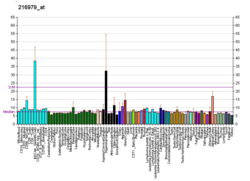The nuclear receptor 4A3 (NR4A3) (nuclear receptor subfamily 4, group A, member 3) also known as neuron-derived orphan receptor 1 (NOR1) is a protein that in humans is encoded by the NR4A3 gene. [5] NR4A3 is a member of the nuclear receptor family of intracellular transcription factors.
Contents
NR4A3 plays a central regulatory role in cell proliferation, differentiation, mitochondrial respiration, [6] metabolism [7] [8] and apoptosis [9]








